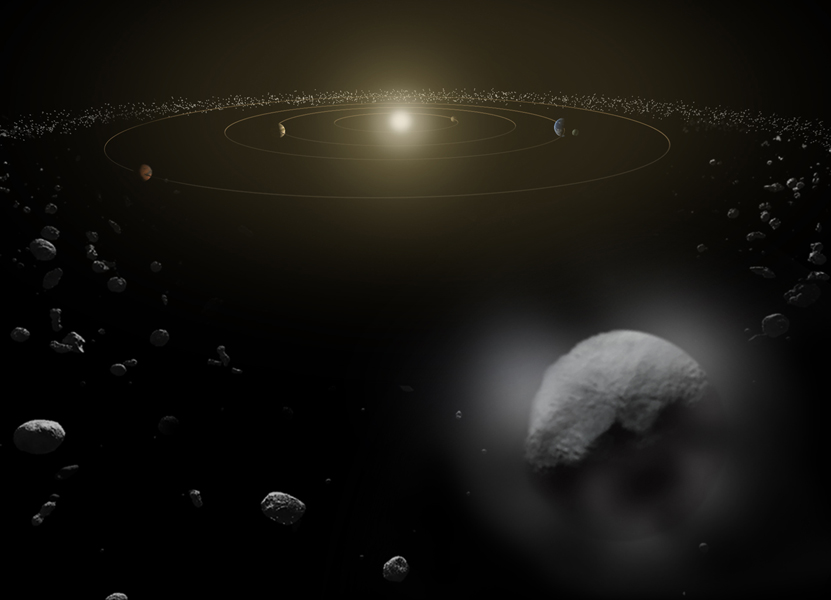Herschel telescope detects water on dwarf planet
January 27, 2014

Dwarf planet Ceres is located in the main asteroid belt, between the orbits of Mars and Jupiter, as illustrated in this artist’s conception (credit: NASA)
Scientists using the Herschel space observatory have made the first definitive detection of water vapor on the largest and roundest object in the asteroid belt, Ceres.
Plumes of water vapor are thought to shoot up periodically from Ceres when portions of its icy surface warm slightly. Ceres is classified as a dwarf planet, a solar system body bigger than an asteroid and smaller than a planet.
“This is the first time water vapor has been unequivocally detected on Ceres or any other object in the asteroid belt and provides proof that Ceres has an icy surface and an atmosphere,” said Michael Küppers of European Space Agency (ESA) in Spain, lead author of a paper in the journal Nature.
The results come at the right time for NASA’s Dawn mission, which is on its way to Ceres now after spending more than a year orbiting the large asteroid Vesta. Dawn is scheduled to arrive at Ceres in the spring of 2015, where it will take the closest look ever at its surface.
“We’ve got a spacecraft on the way to Ceres, so we don’t have to wait long before getting more context on this intriguing result, right from the source itself,” said Carol Raymond, the deputy principal investigator for Dawn at NASA’s Jet Propulsion Laboratory in Pasadena, Calif. “Dawn will map the geology and chemistry of the surface in high resolution, revealing the processes that drive the outgassing activity.”
More fresh water than on Earth
Scientists believe Ceres contains rock in its interior with a thick mantle of ice that, if melted, would amount to more fresh water than is present on all of Earth. The materials making up Ceres likely date from the first few million years of our solar system’s existence and accumulated before the planets formed.
The results are somewhat unexpected because comets, the icier cousins of asteroids, are known typically to sprout jets and plumes, while objects in the asteroid belt are not.
“The lines are becoming more and more blurred between comets and asteroids,” said Seungwon Lee of JPL, who helped with the water vapor models along with Paul von Allmen, also of JPL. “We knew before about main belt asteroids that show comet-like activity, but this is the first detection of water vapor in an asteroid-like object.”
Abstract of Nature paper
The ‘snowline’ conventionally divides Solar System objects into dry bodies, ranging out to the main asteroid belt, and icy bodies beyond the belt. Models suggest that some of the icy bodies may have migrated into the asteroid belt. Recent observations indicate the presence of water ice on the surface of some asteroids, with sublimation a potential reason for the dust activity observed on others. Hydrated minerals have been found on the surface of the largest object in the asteroid belt, the dwarf planet (1) Ceres, which is thought to be differentiated into a silicate core with an icy mantle. The presence of water vapour around Ceres was suggested by a marginal detection of the photodissociation product of water, hydroxyl, but could not be confirmed by later, more sensitive observations. Here we report the detection of water vapour around Ceres, with at least 1026 molecules being produced per second, originating from localized sources that seem to be linked to mid-latitude regions on the surface. The water evaporation could be due to comet-like sublimation or to cryo-volcanism, in which volcanoes erupt volatiles such as water instead of molten rocks.